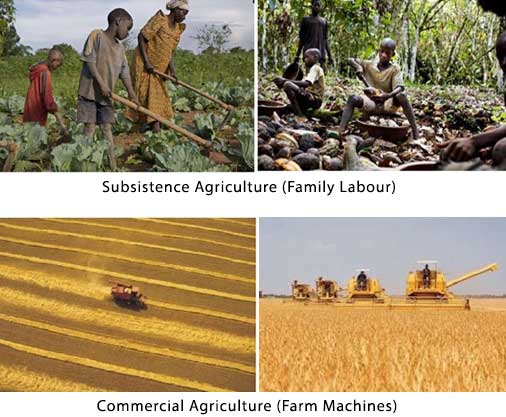Exploring the Trick Distinctions Between Commercial Farming vs Subsistence Farming
Exploring the Trick Distinctions Between Commercial Farming vs Subsistence Farming
Blog Article
Checking Out the Distinctions Between Commercial Farming and Subsistence Farming Practices
The duality between business and subsistence farming techniques is marked by differing objectives, functional scales, and source utilization, each with profound effects for both the environment and culture. On the other hand, subsistence farming emphasizes self-sufficiency, leveraging traditional methods to sustain household demands while nurturing area bonds and social heritage.
Economic Purposes
Economic goals in farming methods typically determine the techniques and range of procedures. In industrial farming, the main financial goal is to make best use of profit.
In contrast, subsistence farming is mostly oriented towards meeting the instant demands of the farmer's family, with surplus manufacturing being marginal - commercial farming vs subsistence farming. While business farming is profit-driven, subsistence farming is centered around sustainability and durability, reflecting an essentially various set of financial imperatives.

Scale of Procedures
The distinction between industrial and subsistence farming comes to be especially obvious when thinking about the range of procedures. The scale of business farming enables for economic climates of scale, resulting in minimized costs per unit through mass manufacturing, raised efficiency, and the capacity to spend in technical improvements.
In stark contrast, subsistence farming is normally small-scale, concentrating on generating just sufficient food to meet the immediate demands of the farmer's family members or neighborhood neighborhood. The land location associated with subsistence farming is often restricted, with less accessibility to contemporary technology or automation. This smaller scale of operations shows a dependence on traditional farming techniques, such as hand-operated labor and straightforward tools, resulting in lower performance. Subsistence farms prioritize sustainability and self-sufficiency over revenue, with any kind of excess typically traded or traded within neighborhood markets.
Resource Usage
Resource use in farming practices reveals substantial distinctions between business and subsistence approaches. Business farming, defined by massive operations, frequently utilizes advanced technologies and mechanization to enhance using sources such as land, water, and plant foods. These techniques permit enhanced performance and greater performance. The focus is on taking full advantage of outcomes by leveraging economic climates of scale and deploying sources tactically to guarantee regular supply and success. Accuracy agriculture is progressively embraced in industrial farming, making use of information analytics and satellite innovation to check crop health and wellness and enhance source application, more improving return and resource efficiency.
In comparison, subsistence farming runs on a much smaller sized scale, primarily to meet the instant demands of the farmer's home. Source usage in subsistence farming is usually restricted by financial restrictions and a dependence on standard techniques.
Environmental Impact

Alternatively, subsistence farming, practiced on a smaller scale, generally uses traditional techniques that are more attuned to the surrounding environment. Crop rotation, intercropping, and natural fertilizing prevail, promoting soil health and reducing the need for artificial inputs. While subsistence farming typically has a lower ecological impact, it is not without challenges. Over-cultivation and poor land management can result in dirt disintegration and logging in many cases.
Social and Cultural Ramifications
Farming practices are deeply linked with the cultural and social fabric of communities, affecting and mirroring their worths, practices, and economic structures. In subsistence farming, the emphasis is on growing adequate food to meet the immediate demands of the farmer's household, commonly fostering a solid sense of neighborhood and shared obligation. Such techniques are deeply rooted in local customs, with knowledge gave via generations, therefore maintaining cultural heritage and enhancing common connections.
Alternatively, industrial farming is largely driven by market demands and productivity, frequently leading to a shift in the direction of monocultures and large-scale procedures. This strategy can cause the disintegration of traditional farming this hyperlink methods and cultural identities, as local customs and expertise are replaced by standard, commercial approaches. In addition, the focus on effectiveness and earnings can in some cases lessen the social communication found in subsistence areas, as financial purchases replace community-based exchanges.
The dichotomy between these farming practices highlights the more comprehensive social effects of farming selections. While subsistence farming sustains cultural continuity and community connection, commercial farming straightens with globalization and financial growth, usually at the price of conventional social frameworks and cultural diversity. commercial farming vs subsistence farming. Balancing these facets continues to be a critical difficulty for lasting farming growth
Final Thought
The exam of industrial and subsistence farming methods discloses considerable differences in purposes, scale, source usage, ecological influence, and social ramifications. Industrial farming prioritizes earnings and efficiency with massive operations and advanced technologies, commonly at the cost of ecological sustainability. Conversely, subsistence farming highlights self-sufficiency, making use of local resources and typical approaches, therefore promoting cultural preservation and area cohesion. These contrasting techniques emphasize the intricate interplay between economic development and the need for socially comprehensive and ecologically lasting farming practices.
The duality between business and subsistence farming methods is noted by differing purposes, functional scales, and resource usage, each with profound implications for both the environment and culture. While commercial Get More Info farming is profit-driven, subsistence farming is focused around sustainability and durability, showing an essentially different collection of financial imperatives.
The difference in between business and subsistence farming comes to be especially apparent when taking into consideration the scale of procedures. While subsistence farming supports cultural continuity and neighborhood interdependence, commercial farming lines up with globalization and economic development, typically at the price of conventional social structures and cultural variety.The examination of commercial and subsistence farming web methods discloses considerable distinctions in purposes, range, source usage, environmental impact, and social implications.
Report this page